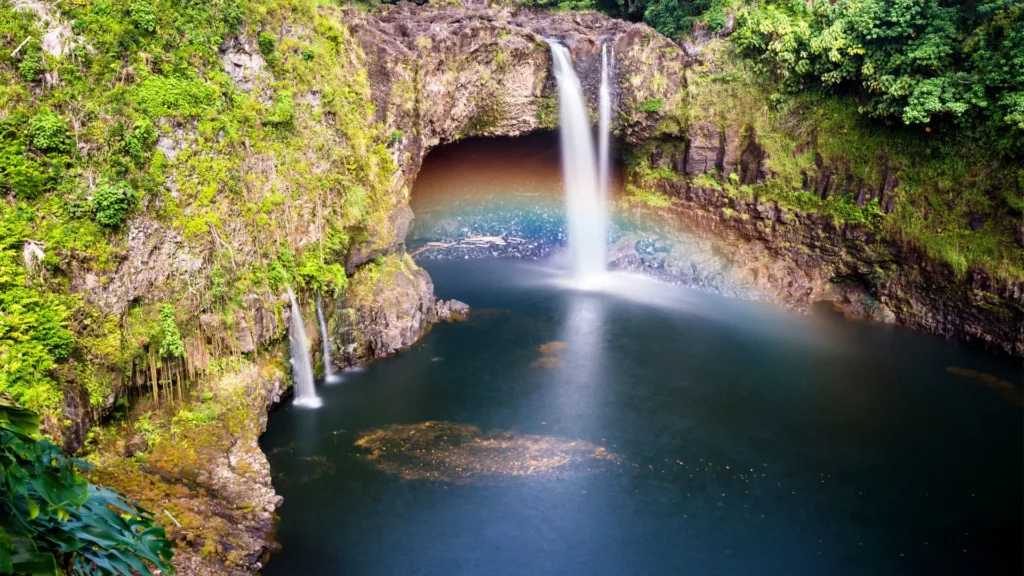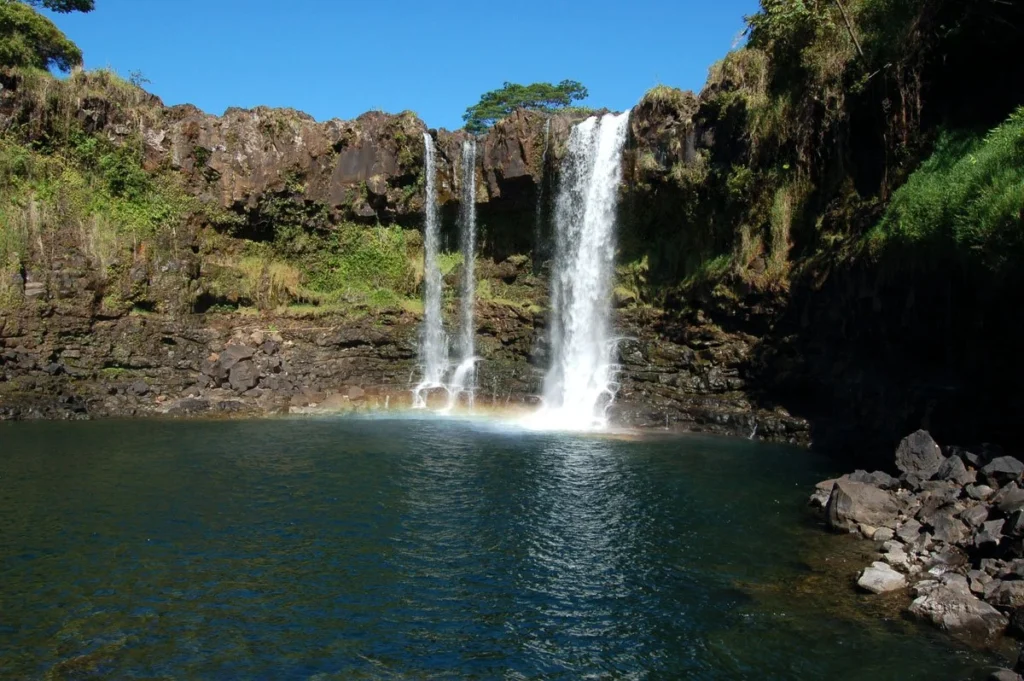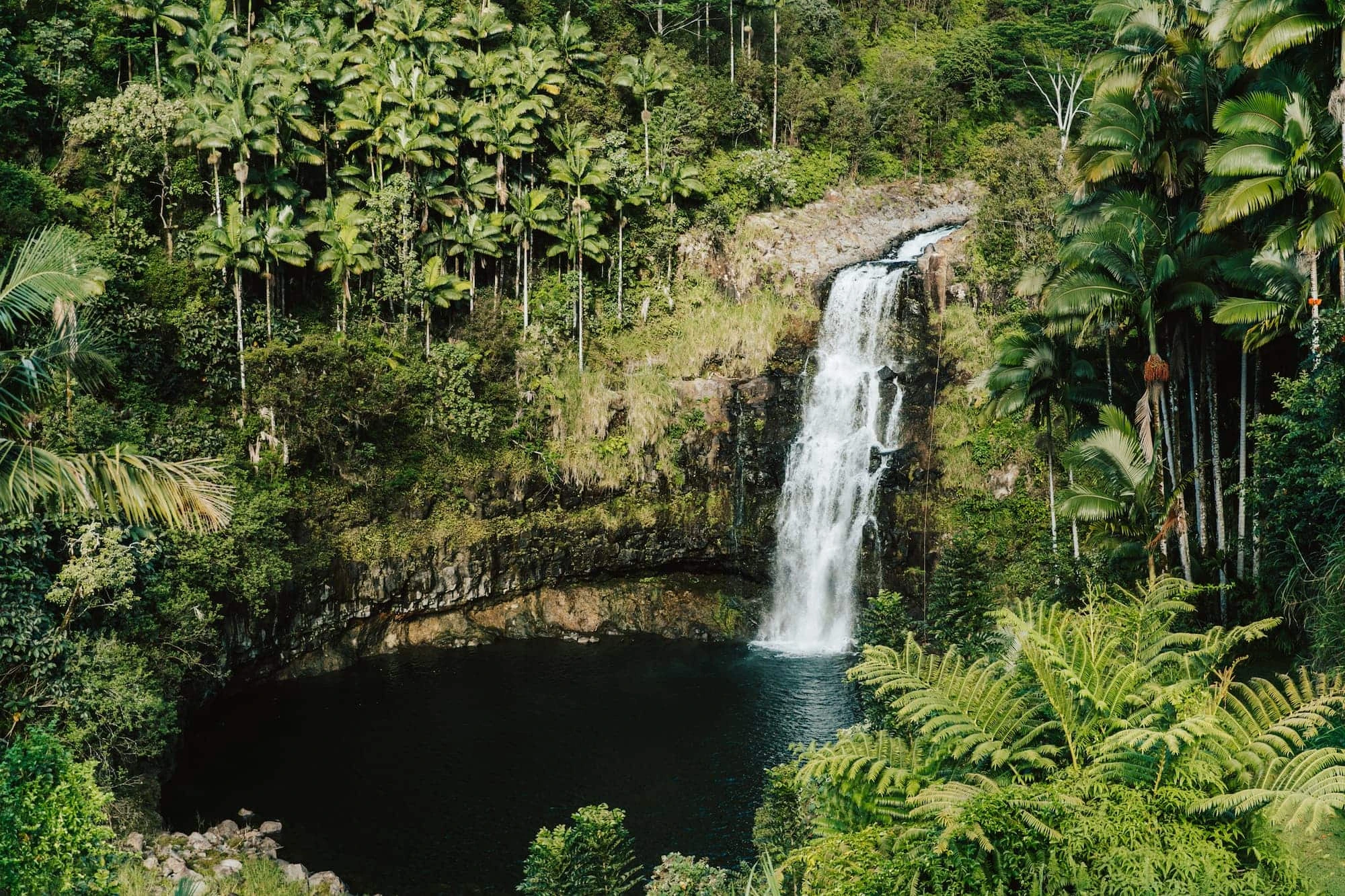Hawaii’s Big Island is synonymous with vivid rainforests, volcanic peaks, and pristine beaches, but it’s the waterfalls in the big island that truly captivate every visitor’s heart. Imagine emerald-green jungles giving way to spectacular cascades of water – nature at its most dramatic and serene. Exploring these waterfalls isn’t just about snapping pictures; it’s about connecting with the island’s history, culture, and natural splendor.
If you’re an adventure seeker, a nature enthusiast, or a Hawaii traveler, this guide has everything you need to take a memorable plunge into Big Island’s best waterfalls.
Table of Contents
A Journey Through the Waterfalls in the Big Island
The Waterfalls in the Big Island aren’t just landmarks; they’re experiences. Each one has its personality—from the roaring majesty of Hiilawe Falls to the peaceful trickle of Pe’epe’e Falls. What’s more, every cascade carries a unique place in Hawaiian mythology, such as Rainbow Falls’ ties to the goddess Hina. Visiting these natural wonders offers a blend of beauty and cultural insight that’s quintessentially Hawaiian.
Whether you’re looking for a serene escape or an adrenaline-packed adventure, Big Island’s waterfalls have something for everyone.
My Top 5 Waterfalls in the Big Island to Visit
1. Akaka Falls, State Park

Located within Akaka Falls State Park, this 442-foot waterfall will take your breath away. The paved loop trail offers an easy hike through lush greenery, with exotic flowers and vibrant plants accompanying your walk.
Akaka Falls requires an entrance fee of $5 per vehicle or $1 per pedestrian. The fee covers access to the well-maintained paved trail that takes visitors through lush greenery to the breathtaking 442-foot waterfall.
Pro Tip: Visit in the morning for fewer crowds and the perfect light for photography.
Must See: Look out for smaller Kahuna Falls along the trail for a hidden treasure.
2. Rainbow Falls

Just minutes from Hilo Hawaii, Rainbow Falls is perfect for travelers seeking beauty without a strenuous hike. Shrouded in mist, the falls often create morning rainbows that add a magical touch to the view.
Rainbow Falls, a popular and easily accessible waterfall in Hilo Hawaii, is completely free to visit. There’s no entrance fee or parking cost, making it a favorite spot for locals and tourists alike to admire its beauty and the rainbows that often form in the mist.
Legend: Rainbow Falls is said to be home to Hina, the goddess of the moon. Learning about these legends brings a deeper appreciation to your visit.
Accessibility: The falls offer easy parking and a short walk to the lookout.
3. Hiilawe Falls

Hidden deep in the sacred Waipio Valley, Hiilawe Falls is Big Island’s tallest at around 1,450 feet. Seeing this cascade up close is a true reward after navigating the valley’s rugged trails.
Hiilawe Falls, the tallest waterfall on the island, doesn’t have a direct fee for viewing. However, because it is located in Waipio Valley, costs may arise from guided tours or renting a 4WD vehicle to navigate the steep and rugged terrain of the valley.
Adventure Level: Guided 4x4 or horseback tours are excellent alternatives if hiking isn’t your style.
Cultural Significance: Waipio Valley is known as the “Valley of the Kings," rich in Hawaiian history and folklore.
4. Pe’epe’e Falls

A quick detour from Rainbow Falls, Pe’epe’e Falls provides a more tranquil ambience. Known for its unique cascading streams, it’s a less-crowded spot to enjoy the sounds of nature.
Pe’epe’e Falls, another serene and scenic spot near Hilo Hawaii, is also free to visit. Like Rainbow Falls, it’s a public area with no charges for entry or parking, making it a peaceful and budget-friendly destination for nature lovers.
What’s Nearby: Pair your visit with a stop at Boiling Pots, a series of volcanic pools with fascinating swirling waters.
Perfect For: A peaceful afternoon picnic.
5. Umauma Falls

This triple-tiered waterfall offers both incredible beauty and thrilling activities like zip-lining over the falls. It’s fun for families and adventure enthusiasts alike, with surrounding gardens perfect for a slower-paced visit.
Umauma Falls is part of the privately operated Umauma Experience. While there isn’t a standard entrance fee, access to the falls is typically included in adventure packages such as zip-lining or garden tours. Visitors looking to explore this triple-tiered waterfall should plan for these activity-related costs.
Don’t Miss: Take a guided tour of the Umauma Experience for even more memorable moments.
Photo Tip: Use a tripod for silky-smooth shots of the cascading water.
Exploring Responsibly and Safely
Visiting waterfalls is a treat, but it’s essential to respect both nature and local guidelines. Keep these tips in mind as you plan your adventures:
- Stay on Trails: Protect fragile ecosystems by sticking to marked trails.
- Heed Warnings: Pay attention to signs and avoid swimming in areas with strong currents or rapid water flows.
- Practice Leave No Trace: Carry out what you carry in to keep these environments pristine for generations to come.
The Best Times to Visit
The intensity of Big Island’s waterfalls can vary depending on the season. For the best experience:
- Spring Months (March to May): Ideal for lush greenery and consistent water flow.
- Rainy Season (November to March): Waterfalls often reach their peak flow, but trails can be muddy, so pack proper gear.
Whenever you choose to visit, plan to go early in the day to beat the crowds and enjoy softer natural lighting.
Hiking Trails to Consider
Exploring Big Island’s waterfalls often involves hiking through verdant landscapes. Here are some trails worth considering:
- Akaka Falls Loop Trail: An easy 0.4-mile path suitable for all ages.
- Waipio Valley Trail: A challenging yet rewarding hike for experienced adventurers. Be prepared for steep inclines and breathtaking views.
- Umauma Gardens: Ideal for short, family-friendly walks around manicured gardens and stunning views.
Capturing the Perfect Waterfall Shot
Want photos that truly capture the magic of Big Island’s waterfalls? Try these tips:
- Golden Hour: Visit early in the morning or late afternoon for the softest, most flattering light.
- Use a Tripod: Achieve stunning long exposure shots that make the water look silky-smooth.
- Add Depth: Frame your photos with foreground elements like rocks or plants.
- Be Present: While snapping photos is great, don’t forget to put your camera down and soak in the moment.
Waterfalls That Stay With You
Every waterfall on Big Island carries a story, from the roaring power of Hiilawe Falls to the serene beauty of Pe’epe’e Falls. They’re more than picturesque landmarks—they’re experiences waiting to be cherished. Whether you’re a solo adventurer or traveling with loved ones, these waterfalls will leave you inspired and rejuvenated.
Start planning your Big Island trip today and explore the cascading wonders waiting for you.
Continue Reading
Kailua Kona: Best Things To Do in Kona Hawaii Big Island
Best Things to Do in Hilo Hawaii: A Personal Guide to the Best Activities
FAQ About Waterfalls in the Big Island
Are all the waterfalls on the Big Island accessible to the public?
Most of the waterfalls mentioned, like Akaka Falls, Rainbow Falls, and Pe’epe’e Falls, are publicly accessible. However, some, like Umauma Falls, are on private property and require entry through guided tours or adventure packages.
Do I need to pay an entrance fee to visit the waterfalls?
It depends on the waterfall. Akaka Falls has an entrance fee of $5 per vehicle or $1 per pedestrian, and Umauma Falls requires payment as part of an adventure experience. Others, like Rainbow Falls and Pe’epe’e Falls, are free to visit.
What is the most beautiful waterfall on the Big Island?
While beauty is subjective, many visitors consider Akaka Falls the most beautiful waterfall on the Big Island. Its sheer height of 442 feet, surrounded by lush greenery and tropical flowers, makes it a must-see destination. The easy access via a paved trail also allows visitors of all abilities to enjoy its grandeur.
How many waterfalls are on the Big Island?
The Big Island is home to dozens of waterfalls, ranging from world-famous attractions like Rainbow Falls and Akaka Falls to smaller, hidden gems nestled in rainforests or along hiking trails. The exact number can vary depending on rainfall and seasonal changes, as some smaller waterfalls appear only during the wetter months.
Is Akaka Falls worth visiting?
Absolutely! Akaka Falls is one of the most iconic waterfalls in Hawaii, offering an unforgettable experience. The short, paved loop trail through a lush rainforest to the viewing platform is accessible and family-friendly, making it a perfect stop for all ages. Its dramatic drop and scenic surroundings make it a favorite for photography and nature enthusiasts alike.
Why is Akaka Falls famous?
Akaka Falls is famous for its breathtaking height and easy accessibility. Its 442-foot drop into a gorge is a stunning natural spectacle, and the surrounding state park offers a beautiful, immersive rainforest experience. Additionally, its prominence in Hawaiian culture and frequent appearance in travel guides and media have solidified its reputation as a must-visit attraction on the Big Island.
Can I swim in the waterfalls on the Big Island?
Swimming is allowed in some areas, but it’s essential to check for local warnings or conditions, as currents can be strong and dangerous. For example, Rainbow Falls and Pe’epe’e Falls are not safe for swimming, while other less popular spots might offer safe access.
What is the best time of year to visit Big Island waterfalls?
Spring and fall are ideal for visiting Big Island waterfalls. The waterfalls tend to have more flow during the rainy season, but trails may be muddy. Summer offers clearer weather and more accessible paths but with lower water flow in some areas.
How difficult are the hiking trails to these waterfalls?
Trails range from easy to challenging. Akaka Falls has a short, paved loop trail suitable for all ages, while reaching Hiilawe Falls in Waipio Valley requires navigating steep terrain and may require a guided tour or 4WD access.

